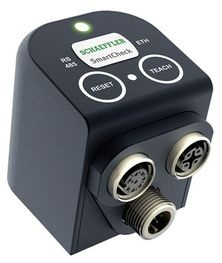Supported device types and versions
Document revisions
Configuration of communication
The SmartCheck from Schaeffler is a compact, innovative, modular online measuring system for continuous monitoring of machinery and process parameters on a decentralized basis. It can be used on assemblies where such monitoring was previously too costly.
The SmartCheck is suitable for early detection of rolling bearing damage, imbalances and misalignments on:
- Electric and geared motors
- Vacuum and fluid pumps
- Ventilators and fans
- Gearboxes and compressors
- Spindles and machine tools
Supported device types and versions
The communication with the FAG SmartCheck device has been tested on a device with the following parameters:
- Build date: 20170502_164020
- Build number: 395886
- Firmware: 1.12.2
The protocol for communication with the FAG SmartCheck vibrometer is implemented as a Java server event in D2000.
If the FAG SmartCheck is connected to the local network, it is possible to connect to it using its IP address. Java event communicates with the device by using XML Soap (Simple Object Access Protocol) via http requests. Several types of requests can be sent to the device, D2000 implementation of FAG SmartCheck protocol uses two types of requests:
- authenticate - User's login to the device. Valid username and password are required to execute this request. Only one user can be signed in at one time, so if configuration of the device is to be modified via web interface, communication with D2000 must be stopped.
- liveCharacteristicValue - querying "live" data from the device. These data are collected by device in real-time, such as vibration, temperature, voltage, load, but also the rotational speed of the device.
Communication with the FAG SmartCheck is established using the IP address of device, by following procedure:
- An authenticate request is sent to device. This request uses username and password valid for the device.
- The device sends a response, which will indicate, whether the login to the device was successful.
- If the login was successful, D2000 sends a liveChararacteristicValue request is to the device.
- The device sends measured values a response (vibration, temperature, voltage, load, digital speed).
Configuration of communication:
The structured variable SV.FAG.SmartCheck.Parameters is used to configure communication. This structure has to be dimensioned to as many rows as there are devices. The meaning of each column is as follows:
- DeviceName - Device name defined by user (not used in communication).
- IP - IP address of the device. Example: 172.16.1.128
- User - Username to login to the device.
- Password - Password to login to the device.
- Period - The period (in seconds) at which data is read from the device
- Active - If this column is True, communication is active. The False value disables communication (e.g. if it is necessary to access the device's web interface for configuration).
Output from the communication is written to the structured variable SV.FAG.SmartCheck.Values, which has as many rows, as there are devices. The meaning of each column is as follows:
- Vibration - Device vibrations (g)
- Temperature - Device temperature (°C or °F depending on configuration of the device)
- Voltage - Device voltage (V)
- Load - Device load (%)
- DigitalInput - Device rotational speed (rpm)
- Status - State of communication. It can take on the following values:
- 0 - Connected (communication is ok)
- 1 - Disconnected (communication is stopped)
- 2 - Connection error - Could not connect to device (e.g. the device is not connected to the network, or the machine's IP address is invalid)
- 3- Login error - Username or password is incorrect
If interested in this protocol, please contact the D2000 development department.
Document revisions
- Ver. 1.0 - August 6th, 2019 - Document creation.
Related pages:
